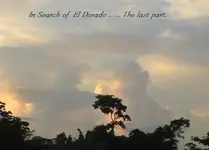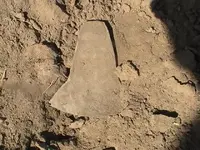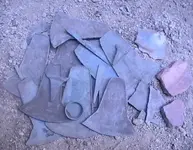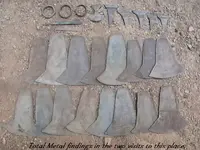HISPAN
Gold Member
- Joined
- Mar 15, 2009
- Messages
- 5,160
- Reaction score
- 605
- Golden Thread
- 0
- Detector(s) used
- WHITES MXT ,GARRET ACE150,GARRET SEA HUNT MARK II.
- Primary Interest:
- Metal Detecting
Hello my friends ! 
This is my last post on this vacations, and wanted to be a little more scientific and explanations .
This place is near the Pacific coast in a remote part of Ecuador. Ecuador is a country in South America where they originated many different cultures from around 3000 BC.
These metal findings are in the last culture that developed here, just before the arrival of the first Spanish , this culture is called Manteño and was contemporary of the Chimu (remember the burial of the Señor de Sipan ) and also of the Incas with whom went to war.
The Manteños were good traders and artisans, carrying their products throughout the Pacific coast (the necklaces of shells and pottery) in this place have appeared a lot of these products .... and also found in two site visits:
6 Tweezers , 3 Rings and 15 Axes - coins.(All done in copper.)
These fifteen axes made from high purity copper were accepted as payment for the pre-Columbian tribes .
With them to purchase goods of value. They are usually found in graves in northern Peru and Ecuador, but in the " fields" where I have been detecting the bones and ash not appeared to show that were buried in a tomb .... rather it is deposited offerings in pottery vessels buried and possibly ask the gods for a good harvest or something similar ( am studying this subject.)
with the flowering of cultures Chincha, Ishma, Chimu, Lambayeque, Tumbes and Manteño , it generated intense functional and trade that stretched from the present-day Peru to Ecuador, even to Mexico. The copper axes, facilitated exchanges between these cultures. On the raft he found the Spanish pilot Ruiz in 1526, at sea at the height of the Ecuadorian coast, shortly before the conquest of Peru, it discovered copper Axes . which demonstrates the use these Axes as a medium of exchange.

This is my last post on this vacations, and wanted to be a little more scientific and explanations .
This place is near the Pacific coast in a remote part of Ecuador. Ecuador is a country in South America where they originated many different cultures from around 3000 BC.
These metal findings are in the last culture that developed here, just before the arrival of the first Spanish , this culture is called Manteño and was contemporary of the Chimu (remember the burial of the Señor de Sipan ) and also of the Incas with whom went to war.
The Manteños were good traders and artisans, carrying their products throughout the Pacific coast (the necklaces of shells and pottery) in this place have appeared a lot of these products .... and also found in two site visits:
6 Tweezers , 3 Rings and 15 Axes - coins.(All done in copper.)
These fifteen axes made from high purity copper were accepted as payment for the pre-Columbian tribes .
With them to purchase goods of value. They are usually found in graves in northern Peru and Ecuador, but in the " fields" where I have been detecting the bones and ash not appeared to show that were buried in a tomb .... rather it is deposited offerings in pottery vessels buried and possibly ask the gods for a good harvest or something similar ( am studying this subject.)
with the flowering of cultures Chincha, Ishma, Chimu, Lambayeque, Tumbes and Manteño , it generated intense functional and trade that stretched from the present-day Peru to Ecuador, even to Mexico. The copper axes, facilitated exchanges between these cultures. On the raft he found the Spanish pilot Ruiz in 1526, at sea at the height of the Ecuadorian coast, shortly before the conquest of Peru, it discovered copper Axes . which demonstrates the use these Axes as a medium of exchange.
Amazon Forum Fav 👍
Attachments
Upvote
0





















